PanzerKampfWagen III
PzKpfw III Ausf. M (1942-43)
|
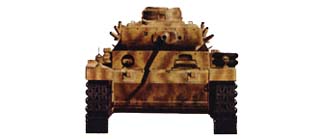 |
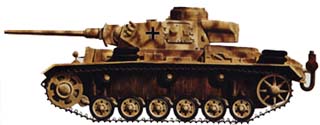 |
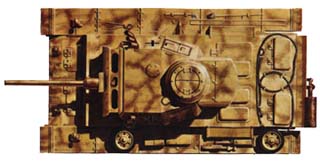 |
|
| Weigth |
21,3 tons |
| Crew |
5 |
| Weapons |
50mm L60 KwK 39 gun with 98 rounds, 2 7,92mm
MG 34 with 2550 rounds |
| Armor |
hull ??-70mm (nose 50mm, front 50mm+20mm,
sides and rear 80mm, top ??mm, bottom ??mm);
turret 30-77mm (front 57mm+20mm, sides and rear
30mm, top ??mm) |
| Engine |
300hp gasoline Maybach HL 120 TRM,
12-cylinders on V, liquid cooled |
| Speed |
40Km/h |
| Autonomy |
150Km |
| Length (max) |
6,55m |
| Width |
2,97m |
| Height |
2,51m |
|
Advantages: upgradability in both armor and gun, mechanical
reliability due to highly experienced chassis
Disadvantages: turret too small to accomodate the long
barreled 75mm L43 (as in the PzKpfw IV)
In action...
In 1936 german industry passed to develope a true battle tank
using the experiences got with the previous panzers. Panzer III
Ausf. E (Sd.Kfz. 141), armed with a 37mm L46 gun (muzzle speed of
762 m/s), appeared in less than a hundred (previous III models
included) during the polish campaign. Circa 300 Panzer III were
ready for French campaign, too few to fill the Panzerdivisionen's
order of battle and so being often replaced by the light PzKpfw
38(t)s, 35(t)s and IIs; this last operation proved the
"foolness" of using 37mm gun against the heavy armored
tanks such as the Char B1-bis or the british Matildas.
A handful of new Ausf. F, armed with 50mm L42 KwK 38 was
tested in the final days of the campaign. Ausf. Fs and heavier
armored Ausf. Gs formed the bulk of General Rommel's Afrika Korps
when it landed in Libya on 28th February 1941 for reinforcing the
Italian anti-tank defence. Experience on the field proved
necessity of better tropicalization in both engine filters and
turret ventilation.
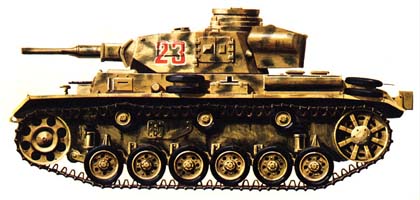 |
Panzer III Ausf. F belonging to
the 15th Panzerdivision (1941)
|
In 1940 only 862 Panzer III were built and when Eastern Front
took the request for 7,992 tanks for equipping 36 divisions the
geman industry, smobilized after the fall of France for a not too
high production, was pressed to satisfy the Army's need. Still in
1941 only 1,713 tanks were built and in 1942 numbers passed to
2,605 panzers (1,907 with new long barreled KwK 39 gun).
In Russia the Panzer III while easily handling the soviets
T-26s and BTs was overmatched by the T-34s and KVs: only using
their better quality troops and equipments (i.e. the 88mm L56
FlaK gun) but also by taking the 105mm and 150mm guns from
indirect support to first line, Germans ("helped" by
Soviet commands' mistaken use) were able to overrun them and
arrive to the gates of Moscow. Autumn-Winter time once proved
that the Panzer III (but also IV) was unable to front the
large-tracked soviets vehicles in any field.
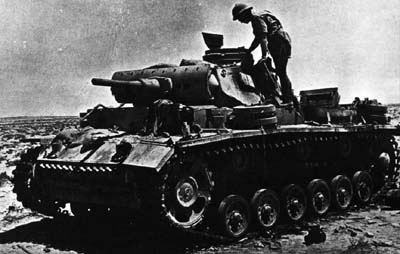 |
Early model Panzer III Ausf. J
(armed with short 50mm gun)
destroyed on the El Alamein front
|
A new tank design was needed and PzKpfw III upgrade could no
longer wait: on January 1942 new Ausf. J with 60mm front armor
and 50mm L60 KwK 39 gun was ready for action and other versions
were progressing: new gun had a 822 m/s muzzle speed with normal
AP ammos and 1,168 m/s using the Panzergrenate 40 (PzGr 40).
Later Ausf. M got 70mm armor and from 1943 schurzen began to be
added on both side hull and turret.
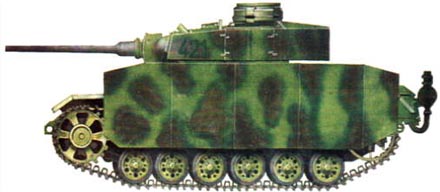 |
Late model Panzer III Ausf. M with
turret and side schurzen
(Photo by Valera Potapov)
|
In late 1942 and start 1943 new (and last) Ausf. N was out of
factory carrying the 75mm L24 gun for an anti-infantry role, some
being assigned to Tiger battalions. From mid 1943 Panzer III
production was cancelled in favor of the more useful and cheaper
StuG III. By the end of the war a total of 15,350 chassis had
been built.
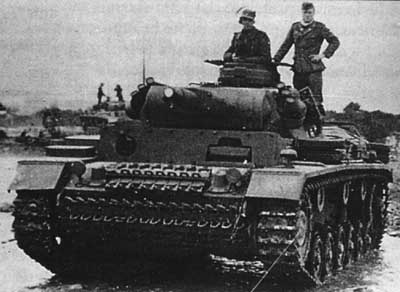 |
Panzer III Ausf. N in Russia
(1943)
|
As final note, Pz. III Ausf. N were also selected and
delivered to equip a company of the Armored Group
"Leonessa" of the Italian "M" Armored
Division. As known these vehicles, along with the Pz. IV Ausf. Gs
and StuG III Gs, never saw action under Italian flag as after the
armistice they were returned to the Germans to equipe the Herman
Goering Division.
PzKpfw III AUSF. N cross-section
|
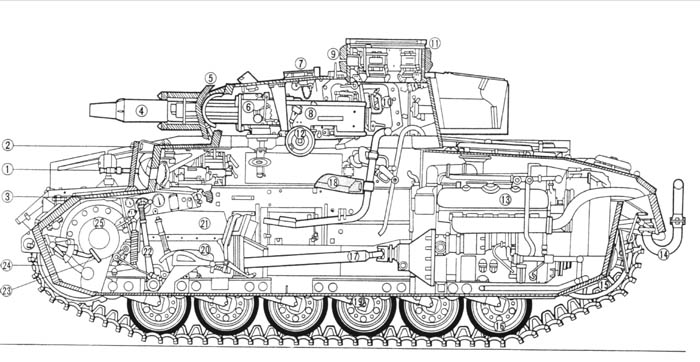 |
1.
7.92mm MG34 TMG
2. Additional 20mm plate
3. Driver cockpit
4. 7,5 cm L24 cannon
5. Gun shield
6. Gun loading system
7. Cooling
8. Anti-recoil shield
9. Cupola sight |
10.
Emergency door
11. Commander's cupola
12. Gun elevation gear
13. Engine
14. Exhaust pipe
15. Return wheel
16. Sprocket wheel
|
17.
Engine transmission
18. Commander's seat
19. Torsion bar suspension
20. Driver's seat
21. Gear box
22. Command clutch
23. Friction pedal
24. Drive-sprocket wheel
25. Dish brakes
|
Panzer III was also used for many types of conversions,
ranging from Beobachtungspanzer to Munitionschlepper (ammo
transport vehicles) and Sturmgeschutz (assault artillery pieces):
this was the most extensive use. [see StuG III/IV section]

|
This page is online thanks to Geocities, the
largest Web Community! Get your own
free page at Geocities!!!
|







